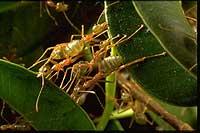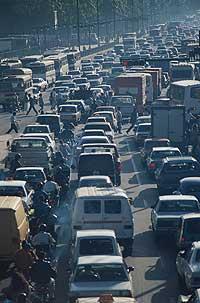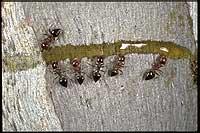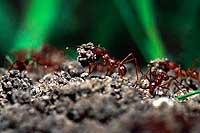Iñurri is a perfect organization

Oecophylla smaragdina Australian ants are very good in construction.
Communication between ants is essential for the functioning of the anthill, since interactions between individuals affect the entire colony. When they go out in search of food, for example, there is a group of ants that disperse. And the rest of the anteaters follow the path of those who return to the anthill.
If the first has reached the anthill, it is the sign that has made the shortest path to the place where the food is located. Cologne should follow the same route, but how do the rest of ants know where to go? Pheromones are the nail of the case. Pheromones are a series of chemicals that ants secrete to mark the way, so that the rest of ants reach where there is food following pheromones.
The more ants you make the journey, the stronger the route will be marked; somehow, a conventional road becomes a highway full of ants. With this type of traffic it is not strange that queues occur. On more than one occasion the road is hindered, however, ants advance, since in the anthill food is constant.

Undoubtedly, the human being is wishing to know the secret of this type of jams, as it can help solve jams or collapses that occur in the telephone network. Apparently, when it is impossible for them to move forward, the ants push each other, so that some of them go out of the blocked path and enter other routes marked with pheromone.
Spying ants
There are many researchers who analyze the behavior of ants. Some of them are in Toulouse. This team of researchers has investigated how ants react when traffic is excessive. Among the experiments carried out there is one that serves to explain the behavior of ants.
Black garden ants ( Lasius niger) were used in this experiment. In a kind of island sugar was placed and at the place of ants were placed two bridges, two of equal length and two of 10 millimeters wide. However, most ants chose one of the bridges, both to go and to come. This shows that ants tend to follow the trail of pioneers and that if a road is firmly marked, they can hardly catch another marked by less ants.
But the experiment was not there. These bridges were replaced by narrower ones, six millimeters wide. And then yes, the ants used both bridges, since being so narrow they began to use a single bridge, but the traffic of ants was too large. The ants pushed each other to lighten the displacement, and gradually more ants used the other bridge.

Both in the laboratory and in a garden looking at ants, it seems that they never stop, and it is the solution they have sought not to have traffic problems. However, it cannot be said that all species of ants play the same thing, since in the world eleven thousand species are known, each of which has its peculiarities. Some are very aggressive; for example, in South America the ants of different anthills face death even if they are of the same species, while European ants can work with ants of different species and do not attack each other, but can distribute the same anthill.
Ants are incredible animals and their behavior may be thought to be investigated as a curiosity, but more applications can be drawn than expected. Among other things, they can help solve the problem of finding the shortest path on computers. In essence, many of the behaviors of ants are susceptible to being translated into the language of computers by statistical methods. That is, the concentration of pheromones in the world of ants is expressed in the computer model as a statistical result.
However, not only is the traffic of ants investigated for data management on computer media. The management system used by some species of ants is also exemplary. Leptothorax unifatus ants, for example, keep colony eggs and microlarbs very orderly and compact in the center of the anthill.

This type of ant colonies can serve as an example to organize and control large sets of small robots. The cooperative transport of ants is especially interesting in these cases, since when an individual cannot carry something can count on the help of its members to carry out collective transport.
In short, the ant is more than a small insect. When they form the anthill, it is more than the sum of a bunch of ants that form an orderly and well organized structure. This organization is the fruit of individual instinct and collective intelligence. Researchers still have where to learn.
Published in 7K.
Buletina
Bidali zure helbide elektronikoa eta jaso asteroko buletina zure sarrera-ontzian











